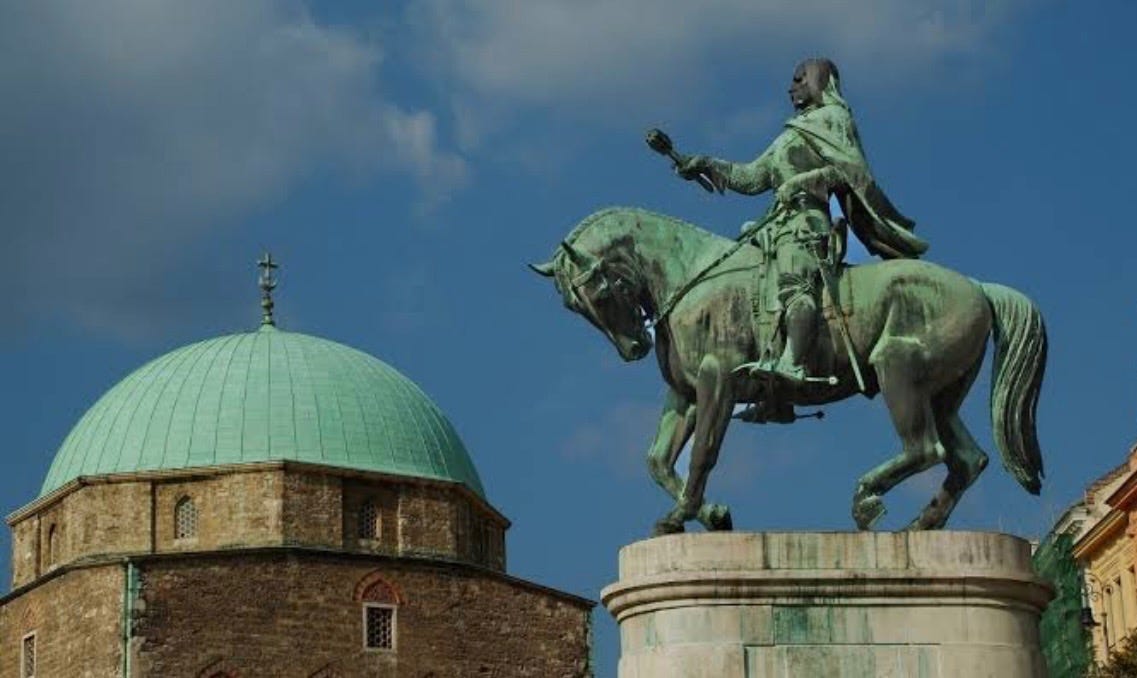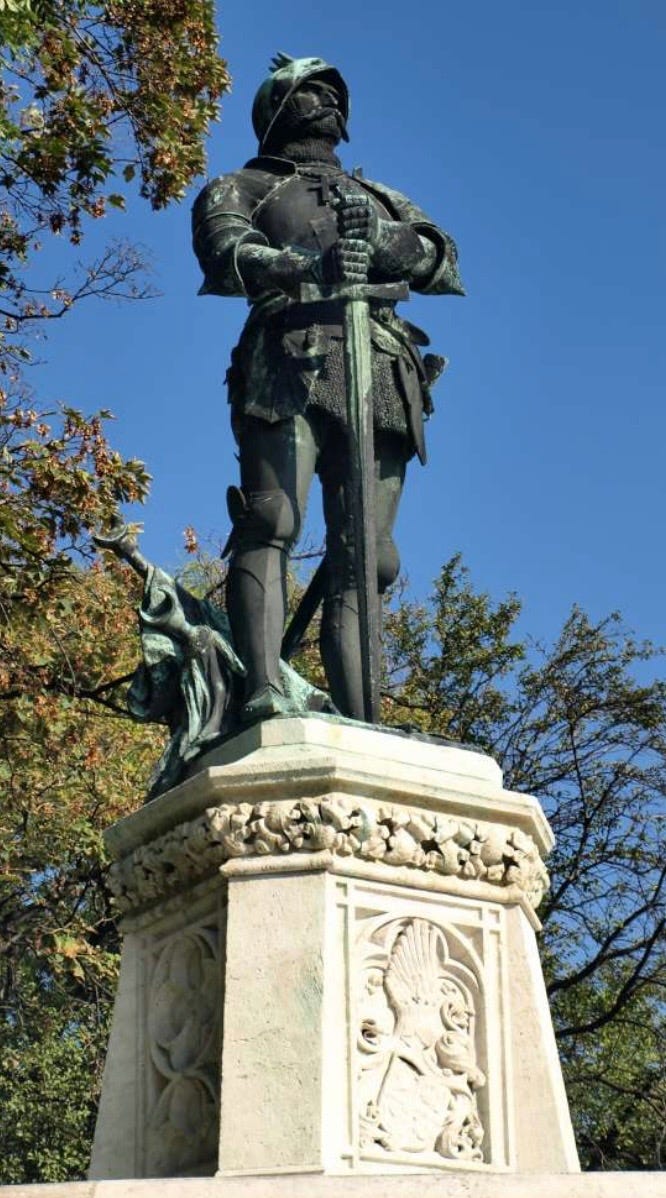Hungarian History Post 6 of 10
The Mongol Empire introduced remarkable innovations in transportation, commerce, taxation, and administrative bureaucracy which were crucial for the management of the largest contiguous empire in history - it extended from the Sea of Japan to the eastern regions of Austria. The repeated 13th century Mongol raids on the territory of Hungary were destabilizing and draining - by the 1290s, a fourth of the population was dead or taken as slaves and conscripted into the Mongol army. The depopulation and economic devastation had a lasting impact - Hungary became fragmented internally and weakened externally… And then came the Turks…
Hungary’s Turkish period deserves a separate post - but first a remarkable family and two of its greatest representatives whose military victories delayed the Turkish takeover of Hungary by 50 years - Hunyadi János (c. 1406-1456) and his son King Mátyás of Hungary (1443-1490).
Hunyadi János, Hungary’s greatest 15th century military leader, earned his nickname “Törökverő” - Turk Defeater - on multiple battlefields. The European conquest by Turkey became possible when Sultan Mehmed II took the Eastern Roman Empire capital Constantinople in 1453. I mentioned this date in my post on Attila - his rapid advance from the North through the Balkans panicked the rulers of the Byzantine Empire - the sea walls of Constantinople were reinforced to prevent Attila’s attack from the sea - which never came. A thousand years later Constantinople ceased to exist, was renamed Istanbul, and became the capital of the newly formed Ottoman Empire. Ottoman Turkey's military might could not be matched by any European country - with the Turkish janissary infantry units becoming the first modern standing army equipped with firearms.
Once Turkey took over Constantinople, the conquest of the Balkans commenced. The brutality of this period cannot be described. In the summer of 2023, I visited every country in the Balkans from Romania to Albania and from Serbia to North Macedonia - reading about and experiencing the 500-year history of the Ottoman wars in the region was destabilizing to say the least. Those of you who read Lord Byron with me - or about my visit to Messolonghi, Greece to commemorate the 200th anniversary of his death - are familiar with my commentary on this subject.
The Hungarian southern frontier, which extended in the 15th century into today’s Romania and Serbia, made the country vulnerable to Turkish attacks. Hunyadi János was appointed the military commander for this entire vast southern region and won several decisive battles against the advancing Turkish armies - at the Battle of Szeben against Mezid Bey and against Beylerbey Sehabeddin, the Turkish governor Rumelia, today’s Bulgaria, both in 1442. Hunyadi János suffered losses at the Battle of Varna in 1444 and Kosovo in 1448, but his military career was crowned with glory during his defense of Belgrade - Nándorfehérvár in Hungarian - in 1456 against troops led by the Ottoman Sultan Mehmed II. The news of the Turkish Siege of Belgrade spread rapidly across terrified Europe with Pope Callixtus III ordering the ringing of church bells in every European city daily at noon between July 4 and 22 in 1456, in solidarity with the inhabitants of Belgrade and the defender of the city, Hunyadi János. His victory over the Turks was celebrated widely all over Europe - unbelievable as this may sound, the tradition of noon church bell ringing that persists to this day originated with the 1456 Hunyadi János victory against the Turks in Belgrade!!!
Eventually, Belgrade was conquered by the Ottomans in 1521. Greece and the entirety of the Balkans were not liberated from Turkish rule till the 19th and 20th centuries. Vienna was besieged by Turkish armies twice, in 1529 and 1683. And Hungary was absorbed into the Ottoman Turkish Empire after its catastrophic loss at the Battle of Mohács in 1526 - more on these events in my upcoming posts.
Hunyadi Castle or Vajdahunyadi vár, today situated in Hunedoara, Romania, one of the largest castles in Europe, was built on the orders of Hunyadi János. The 21st century reconstruction, which resurrected the castle after centuries of decay and neglect, has been criticized for its fanciful inaccuracies. Despite the reconstruction controversies, roaming the halls and courtyards was an awesome - AND exhausting - experience!!!
Hunyadi János at the Battle of Varna, by József Marastoni (1834-1895) and Henrik Weber (1818-1866).
Hunyadi János statue, dedicated in 1956, by Pátzay Pál (1896-1979), in the Hungarian city of Pécs - with the Turkish Mosque in the background - converted into a Catholic Church after the liberation of Hungary. I visited this city with dad in 2020 - his historical narrative was superb!!!
Hunyadi János statue by Tóth István (1861-1934) situated by the grand staircase of the Fisherman’s Bastion at the Buda Castle - he strikes me as very stern and I always make a point of waving to him as I drive up to the top!!!
Please look at the photos dedicated to Heroes’ Square I posted several days ago - Hunyadi János is one of the Hungarian leaders whose statue graces the colonnade - and so is his son, King Mátyás. Please also take a look at the castle behind the colonnade, which looks very similar to Vajdahunyadi vár - it was designed by Ignác Alpár and constructed in 1896 for the Millennial Exhibition commemorating the 1,000th anniversary of the arrival of the Magyars into Europe. Originally built out of wood, the castle reproduction became so popular with the Budapest public that it was reconstructed in stone and brick between 1904 and 1908. Today it houses the Museum of Hungarian Agriculture, the largest agriculture museum in Europe.
Tomorrow - King Mátyás, the illustrious son of Hunyadi János!!!








